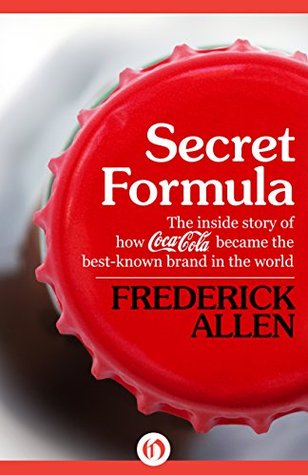More on this book
Kindle Notes & Highlights
Coca-Cola, he conceded, contained no cocaine, and it had only a small, harmless amount of alcohol. The Candlers had won.
Candler took far more pleasure from his burgeoning real estate empire—
Howard Candler’s first permanent assignment for Coca-Cola was to remain in New York and try to bring order to the chaos in the office there.
In a business that relied almost entirely on salesmanship, the boss’s son found it distasteful to talk to the people who bought the product.
Howard described his initiation into what he called the “Holy of Holies,” when his father entrusted him with the secret formula.
Still, it was clear by the end of the trial’s second week that Coca-Cola was getting the better end of things.
The senior lawyers went into court and argued that as a matter of law, the Coca-Cola Company
could not be guilty of adulterating its syrup with caffeine, because caffeine had always been part of the formula.
Coca-Cola had escaped on a technicality.
“There is not one indivisible atom of cocaine in a whole ocean of Coca-Cola.
His first cousin, Howard Candler, had been made president of the Coca-Cola Company.
He liked to drink at least a dozen Cokes a day, sometimes as many as fifteen.
Dobbs had to admit, yet in the wink of an eye he could see the vast potential of selling Coke in bottles.
Bottles with Hutchinson stoppers were notoriously hard to clean and sanitize, and few of the early bottlers even bothered to try.
Candler told Dobbs to confine himself to selling the syrup solely for use at soda fountains.
a bottle of Coke could be shipped anywhere, sold anywhere, consumed anywhere.
Dobbs was an advocate of bottling Coca-Cola long before others joined him in pushing the same idea.
As late as the turn of the century, when production exceeded a quarter of a million gallons and sales were recorded in every state of the union, the corporate headquarters in Atlanta employed only twenty people.
it was the first of twenty thousand Coca-Cola wall signs that eventually punctuated the American landscape.
“dealer helps”: keepsakes, posters, trays, and other items that carried the name “Coca-Cola”
To trigger that impulse, the company sent out thousands of ceramic syrup urns, clocks, metal signs, posters, trays, and decals—
the salesmen gave away thousands
of blotters, paperweights, calendars, and other novelties to anyone who would take them.
Dobbs expected his salesmen to show soda fountain operators how to prepare Coca-Cola properly,
A warm Coca-Cola was a sin.
(It was the expense allowance that made a job with Coca-Cola especially coveted, since the company paid for three restaurant meals a day, lodging in good hotels, and first-class rail travel
salesman’s toughest chores was keeping the merchants from buying cheap, substitute syrup and passing it off as the real thing.
It cost the Candlers less than $1 to manufacture a gallon of syrup,
Asa Candler finally relented and agreed to let independent operators begin bottling and selling Coca-Cola.
Dozens and eventually hundreds of imitators flooded the market with sound-alike soft drinks, among them Afri-Cola, Ameri-Cola, Ala-Cola, Bolama-Cola, Cafe-de-Ola, Carbo-Cola, Candy-Kola, Capa-Cola, Chero-Cola, Christo-Cola, Coke-Ola, Coo-EE-Cola, Curo-Cola, Grap-O-Cola, Its-A-Cola, Kaffir-Kola, Kaw-Kola, Kiss-Kola, Ko-Ca-Ama,
A new era was opening—the company placed a $10,000 order for its first magazine ads in 1902, in Munsey’s monthly—
Massengale inaugurated the use of endorsements of Coke by sports figures of the age.
His ads illustrated thirst and fatigue in social settings and showed people using the product.
The clash between Robinson and Dobbs over advertising came at the same time Asa Candler was beginning to withdraw more and more from the daily operations of the company.
Gaining authority over advertising was the key to gaining control of the whole business.
Dobbs succeeded in discovering one of the great rising talents of the
advertising world, Bill D’Arcy, who would spend the next half-century making history with his work on behalf of Coca-Cola.
He shared Dobbs’s view that Coca-Cola advertising should create scenes that drew people in and made them part of the pleasant interludes of everyday life.
“All classes, ages and sexes drink Coca-Cola,”
In one of his first newspaper ads for Coca-Cola, D’Arcy showed a picture of the baseball star Ty Cobb at bat, and wrote:
A cold, snappy drink of Coca-Cola will put you back in the game—relieve the thirst and cool you off.
“I want that artwork finished so that a man walking or riding down the street and passing this poster will desire that woman.”
D’Arcy introduced the bathing beauty to Coca-Cola’s advertising, and with her the idea that a soft drink could have a role in romance.
In 1908, he created an animated billboard alongside the Pennsylvania Railroad, and travelers from Philadelphia to New York City were treated to the sight of a white-capped clerk serving what appeared to be genuine Coca-Cola
formed an effective partnership overseeing Coca-Cola’s advertising, Dobbs and Hirsch became a force for change in the direction of the company’s legal policies.
brought a renewed spirit of aggressiveness to the defense of Coca-Cola’s trademark.
For the first time, federal trademark law was specifically applied to interstate commerce, giving the company an opportunity to sue infringers in U.S. district court.
Dobbs maneuvered in 1909 to become president of the Associated Advertising Clubs of America, where he helped launch the “Truth in Advertising” movement.
Dobbs became a sort of de facto president of the company,
Dobbs had groomed himself perfectly for the job of running Coca-Cola, only to find that Asa Candler no longer cared about the qualities that enabled a man to do well in business,


